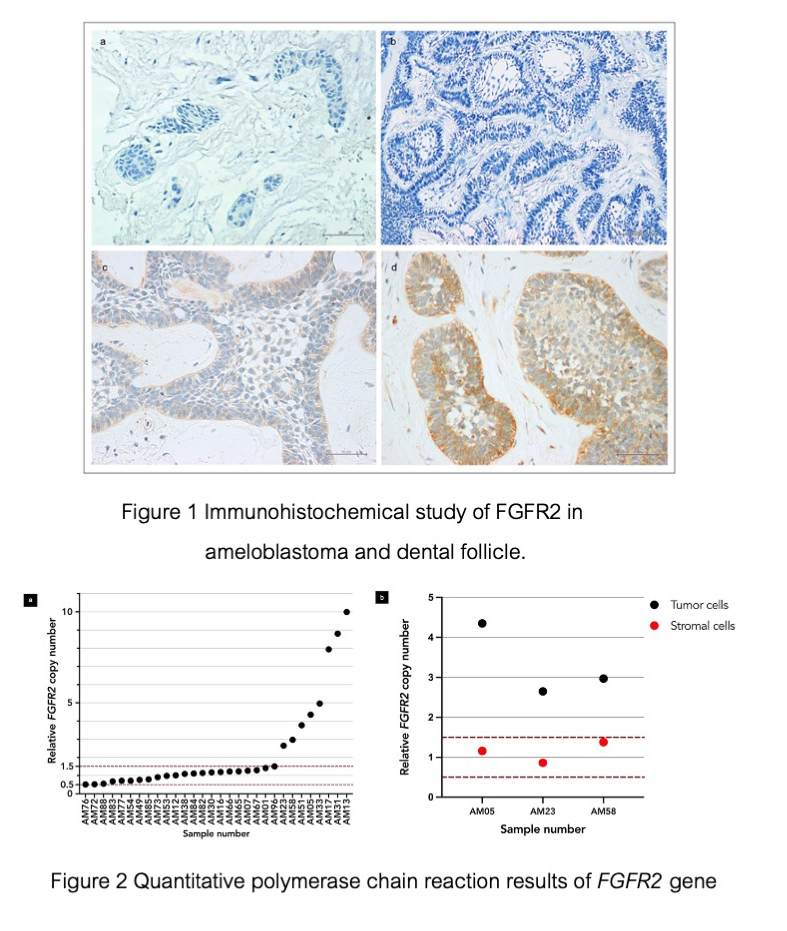High FGFR2 expression associated with gene amplification of FGFR2 in ameloblastoma: a preliminary study
Main Article Content
Abstract
Objectives: This study aimed to investigate the frequency of fibroblast growth factor receptor 2 (FGFR2) gene copy number variation, and expression of FGFR2 protein in a group of Thai ameloblastoma patients with ameloblastoma, and assess any potential associations among FGFR2 protein expression, gene copy number variation, and clinicopathological parameters.
Materials and Methods: Fifty samples of ameloblastoma and five samples of dental follicles preserved in formalin-fixed paraffin-embedded blocks were collected from the archives of Oral Pathology laboratories, Faculty of Dentistry, Chiang Mai University. The expression of FGFR2 protein was examined using an immunohistochemical study. The immunoreaction was recorded by two pathologists using an immunoreactivity scoring system. Subsequently, tissue microdissection was performed, and genomic DNA was extracted using the phenol-chloroform technique. The relative copy number of FGFR2 gene was determined using quantitative real time polymerase chain reaction.
Results: Approximately 66.0% of ameloblastoma samples demonstrated high expression of FGFR2 protein compared to negatively FGFR2 stained dental follicles. No association was identified between FGFR2 protein expression and any clinicopathological parameters. In addition, 73.3% of ameloblastoma cases demonstrated a normal FGFR2 gene copy number, while FGFR2 gene amplification was observed in eight cases (26.7%) of ameloblastoma, while all cases of dental follicle showed a normal FGFR2 gene copy number. Moreover, amplification of FGFR2 gene was statistically significantly associated with high expression of FGFR2 protein (p=0.010).
Conclusions: High expression of FGFR2 protein, as well as FGFR2 gene amplification, were observed in ameloblastoma samples. Additionally, a significant association between FGFR2 gene amplification and high FGFR2 protein expression was identified. Hence, FGFR2 amplification, resulting in high expression of FGFR2 protein and alteration of FGF-MAPK signaling, could play an important role in the tumorigenesis of ameloblastoma.
Article Details

This work is licensed under a Creative Commons Attribution-NonCommercial-NoDerivatives 4.0 International License.
References
Dhanuthai K, Chantarangsu S, Rojanawatsirivej S, Phattarataratip E, Darling M, Jackson-Boeters L, et al. Ameloblastoma: a multicentric study. Oral Surg Oral Med Oral Pathol Oral Radiol. 2012;113(6):782-788. doi:10.1016/j.oooo.2012.01.011
Effiom OA, Ogundana OM, Akinshipo AO, Akintoye SO. Ameloblastoma: current etiopathological concepts and management. Oral Dis. 2018;24(3):307-316. doi:10.1111/odi.12646
Saghravanian N, Salehinejad J, Ghazi N, Shirdel M, Razi M. A 40-year Retrospective Clinicopathological Study of Ameloblastoma in Iran. Asian Pacific Journal of Cancer Prevention. 2016;17(2):619-623.
Kreppel M, Zöller J. Ameloblastoma-Clinical, radiological, and therapeutic findings. Oral Dis. 2018;24(1-2):63-66. doi:10.1111/odi.12702
Brown NA, Betz BL. Ameloblastoma: A Review of Recent Molecular Pathogenetic Discoveries. Biomarkers in Cancer. 2015;7s2:BIC.S29329. doi:10.4137/BIC.S29329
El-Naggar AK, Chan JKC, Grandis JR, Takata T, Slootweg PJ. WHO Classcification of Haed and Neck Tumors. 4 ed: the International Agency for Research on Cancer (IARC); 2017.
Brown NA, Rolland D, McHugh JB, Weigelin HC, Zhao L, Lim MS, et al. Activating FGFR2-RAS-BRAF mutations in ameloblastoma. Clin Cancer Res. 2014;20(21):5517-5526. doi:10.1158/1078-0432.Ccr-14-1069
Guo YJ, Pan WW, Liu SB, Shen ZF, Xu Y, Hu LL. ERK/MAPK signalling pathway and tumorigenesis. Exp Ther Med. 2020;19(3):1997-2007. doi:10.3892/etm.2020.8454
Xie X, Wang Z, Chen F, Yuan Y, Wang J, Liu R, et al. Roles of FGFR in oral carcinogenesis. Cell Prolif. 2016;49(3):261-269. doi:10.1111/cpr.12260
Sweeney RT, McClary AC, Myers BR, Biscocho J, Neahring L, Kwei KA, et al. Identification of recurrent SMO and BRAF mutations in ameloblastomas. Nat Genet. 2014;46(7):722-725. doi:10.1038/ng.2986
Jung EJ, Jung EJ, Min SY, Kim MA, Kim WH. Fibroblast growth factor receptor 2 gene amplification status and its clinicopathologic significance in gastric carcinoma. Hum Pathol. 2012;43(10):1559-1566. doi:10.1016/j.humpath.2011.12.002
Kato H, Arao T, Matsumoto K, Fujita Y, Kimura H, Hayashi H, et al. Gene amplification of EGFR, HER2, FGFR2 and MET in esophageal squamous cell carcinoma. Int J Oncol. 2013;42(4):1151-1158. doi:10.3892/ijo.2013.1830
Matsumoto K, Arao T, Hamaguchi T, Shimada Y, Kato K, Oda I, et al. FGFR2 gene amplification and clinicopathological features in gastric cancer. Br J Cancer. 2012;106(4):727-732. doi:10.1038/bjc.2011.603
Turner N, Lambros MB, Horlings HM, Pearson A, Sharpe R, Natrajan R, et al. Integrative molecular profiling of triple negative breast cancers identifies amplicon drivers and potential therapeutic targets. Oncogene. 2010;29(14):2013-2023. doi:10.1038/onc.2009.489
Sun S, Jiang Y, Zhang G, Song H, Zhang X, Zhang Y, et al. Increased expression of fibroblastic growth factor receptor 2 is correlated with poor prognosis in patients with breast cancer. J Surg Oncol. 2012;105(8):773-779. doi:10.1002/jso.22120
Srisuttee R, Arayataweegool A, Mahattanasakul P, Tangjaturonrasme N, Kerekhanjanarong V, Keelawat S, et al. Evaluation of NID2 promoter methylation for screening of Oral squamous cell carcinoma. BMC Cancer. 2020;20(1):218. doi:10.1186/s12885-020-6692-z
Sambrook J, Russell DW. Purification of nucleic acids by extraction with phenol:chloroform. CSH Protoc. 2006;2006(1). doi:10.1101/pdb.prot4455
Jia Y, Chen L, Jia Q, Dou X, Xu N, Liao DJ. The well-accepted notion that gene amplification contributes to increased expression still remains, after all these years, a reasonable but unproven assumption. J Carcinog. 2016;15:3. doi:10.4103/1477-3163.182809
Matsui A, Ihara T, Suda H, Mikami H, Semba K. Gene amplification: mechanisms and involvement in cancer. Biomol Concepts. 2013;4(6):567-582. doi:10.1515/bmc-2013-0026
Nakao Y, Mitsuyasu T, Kawano S, Nakamura N, Kanda S, Nakamura S. Fibroblast growth factors 7 and 10 are involved in ameloblastoma proliferation via the mitogen-activated protein kinase pathway. Int J Oncol. 2013;43(5):1377-1384. doi:10.3892/ijo.2013.2081
Tang Y, Ji T. Expression of fibroblast growth factor receptor type 2 in primary and recurrent ameloblastoma are correlated with ameloblastoma clinic characteristics. International Journal of Oral and Maxillofacial Surgery. 2017;46:315. doi:https://doi.org/10.1016/j.ijom.2017.02.1061
Minashi K, Yamada T, Hosaka H, Amagai K, Shimizu Y, Kiyozaki H, et al. Cancer-related FGFR2 overexpression and gene amplification in Japanese patients with gastric cancer. Japanese Journal of Clinical Oncology. 2021;51(10):1523-1533. doi:10.1093/jjco/hyab104
Tokunaga R, Imamura Y, Nakamura K, Ishimoto T, Nakagawa S, Miyake K, et al. Fibroblast growth factor receptor 2 expression, but not its genetic amplification, is associated with tumor growth and worse survival in esophagogastric junction adenocarcinoma. Oncotarget. 2016;7(15):19748-19761. doi:10.18632/oncotarget.7782
Lawson-Michod KA, Le CH, Tranesh G, Thomas PC, Bauman JE. Precision medicine: Sustained response to erdafitinib in FGFR2-mutant, multiply recurrent ameloblastoma. Cancer Rep (Hoboken). 2022;5(10):e1656. doi:10.1002/cnr2.1656
Weaver AN, Francisque F, Bowles DW. Tumor Regression After Treatment With Lenvatinib in FGFR2-Mutated Ameloblastoma. JCO Precision Oncology. 2020(4):1403-1406. doi:10.1200/po.20.00175


